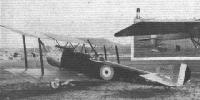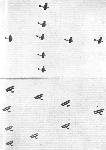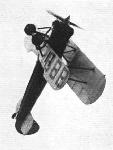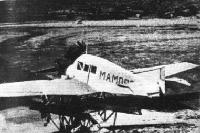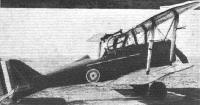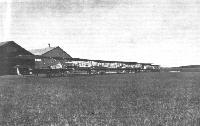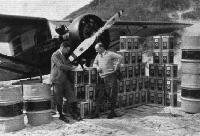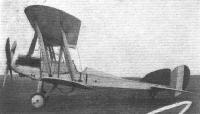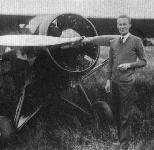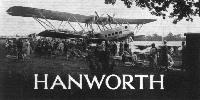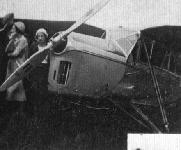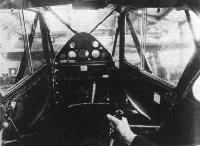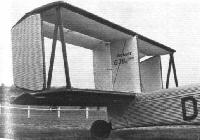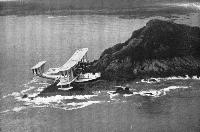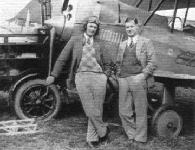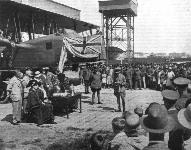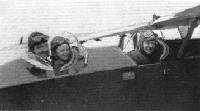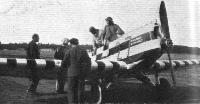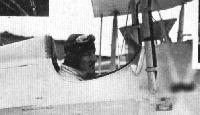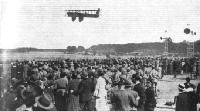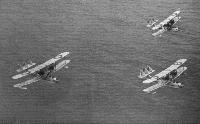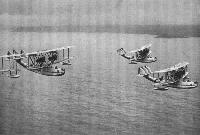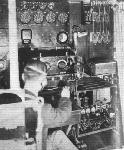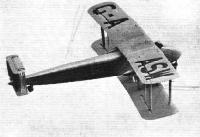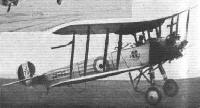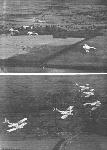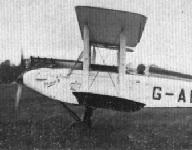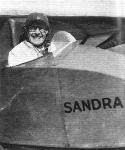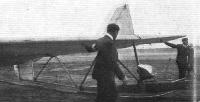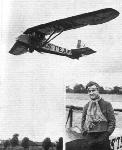Фотографии
-
SOME SUCESSFUL SOPWITHS: THE SNIPE WAS ALSO A USEFUL TYPE, AND ON IT MAJOR BARKER, V.C., FOUGHT 60 GERMANS, AND SHOT DOWN 4.
Самолёты на фотографии: Sopwith Snipe / 7F.1 - Великобритания - 1918
-
MEMBERS OF THE DE HAVILLAND "FAMILY": A LATER TYPE, THE D.H.9A THIS HAD THE AMERICAN LIBERTY ENGINE.
Самолёты на фотографии: De Havilland D.H.9A - Великобритания - 1918
-
ONE OF THREE FAMOUS TYPES: THE SOPWITH 1 1/2-STRUTTER WAS USED BY NOS. 43, 45. AND 70 SQUADRONS UP TO 1917.
Самолёты на фотографии: Sopwith Sopwith 1 1/2-Strutter - Великобритания - 1915
-
OF FRENCH ORIGIN: THE SPAD WAS A BLERIOT PRODUCT, BUT WAS ALSO BUILT IN ENGLAND.
Самолёты на фотографии: SPAD S.VII - Франция - 1916
-
Регистрационный номер: A7995 Aircraft Manufacturing Company-built Eagle-engined DH.4 A7995 at Hendon. Note the windscreen applied to the modified gunner/observer's position, the aircraft probably being used for communications purposes.
Самолёты на фотографии: De Havilland D.H.4 - Великобритания - 1916
-
ONE OF THREE FAMOUS TYPES: THE MORANE-SAULNIER MONOPLANE WAS USED IN LARGE NUMBERS. AND WAS LATER COPIED BY FOKKER;
Самолёты на фотографии: Morane-Saulnier Type G/H - Франция - 1912
-
SOME NEW FORMATIONS WILL BE SEEN AT THIS YEAR'S DISPLAY: THE MACHINES IN THESE ILLUSTRATIONS ARE HAWKER "HARTS" (ROLLS-ROYCE "KESTREL") FLOWN BY NO. 12 (BOMBER) SQUADRON.
Самолёты на фотографии: Hawker Hart - Великобритания - 1928
-
AN OLD TIMER: A replica of a Bleriot monoplane, type XI, which was flown at Hanworth by M. Quatremarre.
Самолёты на фотографии: Bleriot Bleriot-XI - Франция - 1909
-
BORN 1910 AND STILL GOING STRONG: M. Quatremarre flying the Bleriot monoplane at Hanworth.
Самолёты на фотографии: Bleriot Bleriot-XI - Франция - 1909
-
SOME EARLY AEROPLANES: THE BLERIOT MONOPLANE, SHOWN IN 4, WAS A TWO-SEATER. LATERAL CONTROL WAS BY WING-WARPING
Самолёты на фотографии: Bleriot Bleriot-XI - Франция - 1909
-
Регистрационный номер: 226 SOME AIRCRAFT FACTORY PRODUCTS: THE B.E.2 WAS THE FORERUNNER OF A SERIES OF TYPES. IT HAD WARPING WINGS.
Самолёты на фотографии: RAF B.E.2 - Великобритания - 1912
-
Регистрационный номер: 8300 SOME AIRCRAFT FACTORY PRODUCTS: THE B.E.2C WAS FAMOUS FOR ITS STABILITY, AND WAS BUILT IN LARGE NUMBERS DURING THE WAR.
Самолёты на фотографии: RAF B.E.2c/B.E.2d - Великобритания - 1914
-
Регистрационный номер: G-ABBB, K2227 AN UNUSUAL VIEW OF THE BRISTOL "BULLDOG": Mr. C. F. Uwins doing a vertical bank. The picture should be held overhead to give an idea of how the machine appeared to the onlookers.
Самолёты на фотографии: Bristol Bulldog - Великобритания - 1927
-
THE VICKERS "GUN BUS": THIS PHOTOGRAPH SHOWS THE "PROTOTYPE," AND WAS TAKEN BEFORE THE WAR. THE PILOT IS THE LATE MR. HAROLD BARNWELL.
Самолёты на фотографии: Vickers FB.6 - Великобритания - 1914
-
THE AIRWAYS OF BOLIVIA: One of the Junkers machines used by the Lloyd Aero Bolivano are shown in the illustration
Самолёты на фотографии: Junkers F 13 - Германия - 1919
-
THE AIRWAYS OF BOLIVIA: Some of the Junkers machines used by the Lloyd Aero Bolivano are shown in the illustration
Самолёты на фотографии: Junkers F 13 - Германия - 1919
-
Регистрационный номер: A3186 MORE AIRCRAFT FACTORY PRODUCTS: THE R.E.8 WAS A PHOTOGRAPHY AND RECONNAISSANCE MACHINE. AT ONE TIME IT WAS SAID TO BE DANGEROUS, BUT EXPERIENCE TAUGHT PILOTS HOW TO HANDLE IT.
Самолёты на фотографии: RAF R.E.8 - Великобритания - 1916
-
THE BRITISH ARMY BIPLANE: AFTER SEVERAL PREVIOUS ATTEMPTS AT HEAVIER-THAN-AIR FLIGHT, COL. S. F. CODY. IN JANUARY, 1909. SUCCEEDED IN MAKING A "FLIGHT" OF 20 YARDS ON LAFFAN'S PLAIN IN THIS MACHINE, CONSTRUCTED AT THE BALLOON FACTORY, ALDERSHOT.
Самолёты на фотографии: Cody The British Army Aeroplane I - Великобритания - 1908
-
"FACTORY DESIGNED": THE S.E. 5A WAS AN EARLY SINGLE-SEATER FIGHTER, AND WAS FLOWN BY (AMONG OTHERS) MAJOR MANNOCK, V.C.
Самолёты на фотографии: RAF S.E.5 - Великобритания - 1916
-
THE ROYAL FLYING CORPS, MILITARY WING, 1914: THIS PICTURE RECALL THE PRE-WAR DAYS OF THE R.F.C. AND SHOW SOME OF THE MAURICE FARMANS OF "B" FLIGHT AT THE CENTRAL FLYING SCHOOL, UPAVON.
Самолёты на фотографии: Maurice Farman MF.7 Longhorn - Франция - 1912
-
THE "BRISFIT": THE BRISTOL FIGHTER WAS ONE OF THE MOST SUCCESSFUL TYPES DURING THE WAR. IT WAS GIVEN TO NOS. 43, 45 AND 70 SQUADRONS IN 1917.
Самолёты на фотографии: Bristol F.2A/F.2B Fighter - Великобритания - 1916
-
"BORN 1913 AND STILL GOING STRONG": THE AVRO 504, WHICH BEGAN ITS CAREER AS AN OFFENSIVE AIRCRAFT EARLY IN THE WAR, LATER BECAME THE STANDARD TRAINING MACHINE. AMONG ITS EXPLOITS WAS THE BOMBING OF THE ZEPPELIN SHEDS AT FRIEDRICHSHAFEN.
Самолёты на фотографии: Avro Avro 504 - Великобритания - 1913
-
ONE OF THREE FAMOUS TYPES: THE SOPWITH TRIPLANE WAS USED EXTENSIVELY BY R.N.A.S. SQUADRONS IN FRANCE, AND HELPED TO BEAT THE GERMAN ALBATROS AND HALBERSTADT MACHINES.
Самолёты на фотографии: Sopwith Triplane - Великобритания - 1916
-
Регистрационный номер: S1591 Самолёты на фотографии: Armstrong Whitworth Scimitar / A.W.16 / A.W.35 - Великобритания - 1931
-
Michael Detroyat and his Morane Saulnier 230 on which he gave demonstrations of aerobatics.
Самолёты на фотографии: Morane-Saulnier MS.230 - Франция - 1929
-
Walter Lees (right) and Frederic Brossy (left) checking up on their fuel supply before taking off on the record-breaking non-refuelling endurance flight in the Bellanca "Pacemaker" Monoplane with 225 h.p. Packard-Diesel engine.
Самолёты на фотографии: Bellanca Pacemaker / Skyrocket - США - 1928
-
Bellanca "Pacemaker" Monoplane with 225 h.p. Packard-Diesel engine, in which the new World's Non-Refuelling Endurance Record was made by remaining aloft 84 hours 33 minutes, at Jacksonville, Florida, May 25 to 28, 1931.
Самолёты на фотографии: Bellanca Pacemaker / Skyrocket - США - 1928
-
ANOTHER ECHO: Major Sydney Cotton's Bellanca Monoplane, in which he set off to the rescue of Mr. Courtauld. Upon reaching Iceland Major Cotton learned that the rescue had been effected, and then returned home.
Самолёты на фотографии: Bellanca Pacemaker / Skyrocket - США - 1928
-
STRENUOUS BUT USEFUL: There was a close finish in the "Utility Race" between the crews of a Parnall "Elf" and a De Havilland "Puss Moth," the latter arriving on the ground first but gliding a long way, while the "Elf" was landed very near the finishing line.
Самолёты на фотографии: De Havilland Puss Moth / D.H.80 - Великобритания - 1929Parnall Elf - Великобритания - 1929
-
Самолёты на фотографии: Cierva/Avro C.19 - Великобритания - 1929
-
Регистрационный номер: G-AAYP CONVINCING: This photograph shows better than any we have seen the ability of the Cierva "Autogiro" to land in a confined space. The pilot was Mr. Brie.
Самолёты на фотографии: Cierva/Avro C.19 - Великобритания - 1929
-
MORE AIRCRAFT FACTORY PRODUCTS: THE B.E.12 WAS USED, AMONG OTHERS, BY NO.17 SQUADRON AT SALONIKA IN 1917.
Самолёты на фотографии: RAF B.E.12 - Великобритания - 1916
-
Регистрационный номер: K1943 THE "STAR TURN": The Hawker "Fury" (Rolls-Royce "Kestrel") was demonstrated in masterly fashion at Brooklands by Mr. Sayer, Hawker's Test Pilot.
Самолёты на фотографии: Hawker Fury - Великобритания - 1931
-
IN SQUADRON VEE FORMATION: No. 600 City of London Bomber Squadron flying over Hanworth.
Самолёты на фотографии: Westland Wapiti - Великобритания - 1927
-
NEW SERVICE MACHINE AT VINCENNES: The Potez 39 all-metal observation plane (500 h.p. Renault)
Самолёты на фотографии: Potez Potez 37 / 39 / 49 - Франция - 1930
-
Регистрационный номер: J9154 AIRCRAFT TYPES TO BE SEEN IN THE "EAGLE": 5, The Fairey III F, with Armstrong Siddeley "Panther" engine.
Самолёты на фотографии: Fairey Gordon / Seal - Великобритания - 1931
-
THE LOW-LIMIT: Mr. Edwardes, Klemm (Salmson), waiting for the flag. He was first man away and led for many miles en route to Cramlington. Mr. Reynolds is the timekeeper while Capt. Dancy, on his right, looks as if he was satisfied with the work he and Mr. Rowarth had done in handicapping the entries (and rightly so too!).
Самолёты на фотографии: Klemm L.25 - L.28 Swallow - Германия - 1927
-
SEEN AT HESTON: Mr. J. E. Carberry with his Monocoupe.
Самолёты на фотографии: Monocoupe 90 / 110 / 145 - США - 1930
-
Регистрационный номер: G-AAGX An unusual touch was lent to the Parliamentary visit to Hanworth by the presence of a replica of the old Bleriot monoplane, Type XI, and the latest commercial aircraft, the Handley Page "Hannibal." Many of the visitors saw, for the first time, a Bleriot monoplane in flight
Самолёты на фотографии: Handley Page H.P.42 / H.P.45 - Великобритания - 1930
-
SEEN AT HESTON: Mrs. Alan Butler is standing by the nose of her Puss Moth.
Самолёты на фотографии: De Havilland Puss Moth / D.H.80 - Великобритания - 1929
-
THE ORLY MEETING: Miss Winifred Spooner in the "Puss Moth" who also paid a visit to Orly.
Самолёты на фотографии: De Havilland Puss Moth / D.H.80 - Великобритания - 1929
-
A view from the pupils' position of the instrument board lowered. The instruments include clock, revolution indicator, air speed indicator, turn and bank indicator, altimeter, artifical horizon compass and course and drift indicator.
Самолёты на фотографии: De Havilland Puss Moth / D.H.80 - Великобритания - 1929
-
Another view with the instrument board raised. It will be seen that the forward view is now not interfered within in any way at all.
Самолёты на фотографии: De Havilland Puss Moth / D.H.80 - Великобритания - 1929
-
Регистрационный номер: F-ADEK NEW COMMERCIAL MACHINE AT VINCENNES: The Wibault 3-engined (250 h.p. Wright Hispano) all-metal transport
Самолёты на фотографии: Wibault Wibault 280 - Франция - 1930
-
Регистрационный номер: D-2000, D-AZUR THE BUSINESS END OF D.2000: The two inner engines of the Junkers G.38 are Junkers L.88 of 800 h.p. each, while the two other engines are Junkers L.8, of 350 h.p. each.
Самолёты на фотографии: Junkers G 38 - Германия - 1929
-
NOT DECORATIVE: The biplane tail of the Junkers G.38 does not add to the beauty of the machine, but a large-span monoplane tail behind four engines would probably have had an unhappy time of it.
Самолёты на фотографии: Junkers G 38 - Германия - 1929
-
MEMBERS OF THE DE HAVILLAND "FAMILY": IN 4. IS SEEN THE D.H.5, A SINGLE-SEATER FIGHTER WITH 100 LE RHONE ROTARY ENGINE.
Самолёты на фотографии: De Havilland D.H.5 - Великобритания - 1916
-
MEMBERS OF THE DE HAVILLAND "FAMILY": THE D.H.10 WAS A TWIN-ENGINED BOMBER.
Самолёты на фотографии: De Havilland D.H.10 Amiens - Великобритания - 1918
-
An "Iris" (three 650 h.p. "Condors") of No. 209 (Flying Boat) Squadron cruising off the Devon coast.
Самолёты на фотографии: Blackburn Iris / R.B.1 - Великобритания - 1926
-
An "Iris" of No. 209 (Flying Boat) Squadron.
Самолёты на фотографии: Blackburn Iris / R.B.1 - Великобритания - 1926
-
A new version of the Avian, which is now at Heston. It belongs to Cellon, Ltd., and has a 7-cylinder Genet Engine.
Самолёты на фотографии: Avro Avian / Type 594/616 - Великобритания - 1926
-
Регистрационный номер: SE-ACP A. V. Roe & Co., Ltd., have recently supplied an Avian (Hermes II) to the Gothenburg Aero Club. The machine was subscribed for by prominent business men in Gothenburg, and was flown to Sweden by Mr. Gosta Andree, Secretary of the Club.
Самолёты на фотографии: Avro Avian / Type 594/616 - Великобритания - 1926
-
COMPETITORS AND JUDGES: The photograph shows Mr. R. F. Hall and his passenger, Dr. Templeton, who, in a Hermes-Avian, won for the Lancashire Aero Club the S.B.A.C. Cup for a race from London to Bristol.
Самолёты на фотографии: Avro Avian / Type 594/616 - Великобритания - 1926
-
THE ROYAL FLYING CORPS, NAVAL WING: THE NAVAL WING, SUBSEQUENTLY KNOWN AS THE ROYAL NAVAL AIR SERVICE, CARRIED OUT MANY EXPERIMENTS WITH AIRCRAFT CO-OPERATING WITH THE FLEET. HERE WE SEE A SHORT BIPLANE (WITH FLOTATION GEAR) BEING HOISTED ABROAD H.M S. "HIBERNIA." WHICH WAS EQUIPPED WITH A PLATFORM FROM WHICH AIRCRAFT COULD TAKE OFF
Самолёты на фотографии: Short S.33 / S.38 seaplane - Великобритания - 1912
-
No. 500 (County of Kent) (Bomber) Squadron. The first "Virginia" of the new Cadre Squadron at Manston was christened "Isle of Thanet" by the Mayors of Margate and Ramsgate on June 4.
Самолёты на фотографии: Vickers Virginia - Великобритания - 1922
-
A NEW BREGUET TRANSPORT MACHINE: The Breguet 391T is a development of the famous military type 27, but is fitted with three Gnome-Rhone "Titan" engines of 230 h.p. each. The machine has seating accommodation for 10 passengers.
Самолёты на фотографии: Breguet Br.390 - Франция - 1931
-
COMPETITORS AND JUDGES: The photograph shows Mr. H. Thomas, a director of the Bristol Aeroplane Company, and his son setting off from Filton for the Air Port at Whitchurch in a Bristol machine piloted by Mr. Campbell.
Самолёты на фотографии: Bristol Jupiter-Fighter / Advanced Trainer - Великобритания - 1923
-
Регистрационный номер: G-AAZF THE POBJOY ENGINE IN A COMPER "SWIFT": Actually these photographs show an earlier model, but the "R" type will be fitted with a similar cowling.
Самолёты на фотографии: Comper Swift / CLA.7 - Великобритания - 1930
-
"THAT WAS A GOOD AEROPLANE THAT IS": Reversing the now famous "Shell" slogan seems apt in connection with this Hawker "Danecock" with Armstrong-Siddeley "Jaguar" engine which, although delivered by the Hawker Company to the Danish Naval Air Service in 1924, has recently won the Nordic Cup Competition piloted by Lieutenant Erik Rastnussen, Royal Danish Navy. The course was one of 800 miles, and pilots from Norway, Sweden, Finland and Denmark took part. The "Danecock" is still the standard fighter in Denmark, and the same officer and machine still hold the Scandinavian altitude record established just over two years ago.
Самолёты на фотографии: Hawker Woodcock - Великобритания - 1923
-
Регистрационный номер: J7962 HAWKER "WOODCOCK": Single-seater Fighter, with Bristol "Jupiter" Engine
Самолёты на фотографии: Hawker Woodcock - Великобритания - 1923
-
THE HANDLEY PAGE "HYDERABAD" TWIN-ENGINED NIGHT BOMBER.
Самолёты на фотографии: Handley Page Hyderabad/H.P.24 / Hinaidi/H.P.33 / Clive/H.P.35 - Великобритания - 1923
-
NEW TYPE AT ORLY: The Couzinet 3-engined postal plane (40 h.p. Salmson)
Самолёты на фотографии: Couzinet Couzinet 30 / 33 - Франция - 1931
-
WARTIME FLYING BOAT: THE TYPE F.3.
Самолёты на фотографии: Felixstowe F.2 - F.5 - Великобритания - 1917
-
WARTIME FLYING BOAT: THE TYPE F.5.
Самолёты на фотографии: Felixstowe F.2 - F.5 - Великобритания - 1917
-
CODY'S "CATHEDRAL": IT WAS ON A MACHINE OF THIS TYPE THAT CODY WON THE MILITARY TRIALS IN 1912.
Самолёты на фотографии: Cody No.2 / No.3 - Великобритания - 1910
-
The photograph is unique, as our photographer has caught a III F just as the pilot gave the rudder a final kick to enable him to see the deck before landing. The smoke and hot air from the funnel are apt to cause bumps and bad visibility when coming up astern, and it is necessary to slew the aircraft about somewhat before putting her down in order to get a clear view of the deck.
Самолёты на фотографии: Fairey Fairey IIIF - Великобритания - 1926
-
The late Marcel Lalouette, winner of the Reserved Officers Associated Section in the Inter-Club Speed Contest (Vincennes-Tours and return) for the President's Prize. He was flying a Farman 231 (95 h.p. Renault).
Самолёты на фотографии: Farman F.230 / F.350 - Франция - 1930
-
Регистрационный номер: G-ABMW FIRST BRITISH "AVION SANITAIRE": A Desoutter monoplane (Hermes) has been fitted up as a Red Cross machine.
Самолёты на фотографии: Koolhoven FK-41 - Нидерланды - 1928
-
Регистрационный номер: N237 Самолёты на фотографии: Hawker Heron / Hornbill / Hawfinch / Hoopoe - Великобритания - 1925
-
SEEN AT HESTON: FIt.-Lt. Stainforth gets ready for the race in his Spartan.
Самолёты на фотографии: Spartan Arrow - Великобритания - 1930
-
AT VINCENNES: A view of a portion of the crowd and the Grand Stand. - The machine in the air is the Le O 20-3 bomber.
Самолёты на фотографии: Liore et Olivier LeO 203 / 204 / 206 - Франция - 1930
-
THE ESCORT: Liore and Olivier machines accompanied Capt. Costes on the flight to Croydon.
Самолёты на фотографии: Liore et Olivier LeO 203 / 204 / 206 - Франция - 1930
-
NEW SERVICE MACHINE AT VINCENNES: The Le O 20-3 4-engined bomber (Gnome-Rhone "Titan K7")
Самолёты на фотографии: Liore et Olivier LeO 203 / 204 / 206 - Франция - 1930
-
Регистрационный номер: K1947 Westland, following upon the Pterodactyl l experience, elected to forego the Mk. II and III projected tailless fighters in favour of the more modest Mk. IV three-seater research vehicle. The sole example, K1947, first flew in June 1931 and was powered by a 120hp DH Gipsy III. The Mk. IV's maximum achievable speed in level flight was 113mph. Interestingly, in an effort to cure the roller-coaster excursions of the Mk. I, Capt. Hill reverted to using elevons on the Mk. IV, in place of swivelling wingtip, but the pitch control problems appear to have remained unaffected.
Самолёты на фотографии: Westland-Hill Pterodactyl IV - Великобритания - 1931
-
Picture of "Southampton" of No. 204 (Flying Boat) Squadron taking off in Plymouth Sound.
Самолёты на фотографии: Supermarine Southampton / Solent - Великобритания - 1925
-
No. 204 (Flying Boat) Squadron.
Самолёты на фотографии: Supermarine Southampton / Solent - Великобритания - 1925
-
Three "Southamptons" (two Napier "Lion" engines) of No. 204 (Flying Boat) Squadron in formation off the Devon coast.
Самолёты на фотографии: Supermarine Southampton / Solent - Великобритания - 1925
-
Officers and Airmen of No. 204 (Flying Boat) Squadron.
Самолёты на фотографии: Supermarine Southampton / Solent - Великобритания - 1925
-
Picture of "Southamptons" of No. 204 (Flying Boat) Squadron taking off in Plymouth Sound. The breakwater can be seen ahead.
Самолёты на фотографии: Supermarine Southampton / Solent - Великобритания - 1925
-
Picture of "Southamptons" of No. 204 (Flying Boat) Squadron taking off in Plymouth Sound.
Самолёты на фотографии: Supermarine Southampton / Solent - Великобритания - 1925
-
Регистрационный номер: F-ALJC THE BARNARD "CIRCUS" AT THE BRISTOL AIRPORT: A Potez with "Bees a Securete," or slots fitted permanently open.
Самолёты на фотографии: Potez Potez 36 - Франция - 1929
-
Регистрационный номер: G-ABFB WIRELESS EQUIPMENT OF "KENT" FLYING BOATS: In our issue for May 15 we described the Marconi Wireless Equipment installed in the Short "Kent" flying boats used on Imperial Airways. We are now able to give illustration showing one of the flying boats with the masts and aerials which enable the pilot to communicate when on the water
Самолёты на фотографии: Short Kent / S.17 - Великобритания - 1931
-
WIRELESS EQUIPMENT OF "KENT" FLYING BOATS: In our issue for May 15 we described the Marconi Wireless Equipment installed in the Short "Kent" flying boats used on Imperial Airways. We are now able to give illustration showing the receiving and transmitting equipment installed in the hull
Самолёты на фотографии: Short Kent / S.17 - Великобритания - 1931
-
A VISITOR AT VINCENNES: During (he National Aviation Meeting at Vincennes on May 24-25 (reported in our issue for June 5), the Bleriot "125" twin-fuselage bi-motor monoplane provided one of the chief items of interest amongst the new types presented.
Самолёты на фотографии: Bleriot Bleriot-125 - Франция - 1931
-
Регистрационный номер: G-AASW THE HEAVY STUFF: Although a freight carrier, the Vickers "Vellore" (2 "Jupiters") was looped and generally stunted by Mr. Summers at the Brooklands Meeting.
Самолёты на фотографии: Vickers Vellore / Vellox - Великобритания - 1928
-
Регистрационный номер: J8738 THE AVRO "LYNX" IS A TRAINING MACHINE.
Самолёты на фотографии: Avro Avro 504N - Великобритания - 1920
-
Регистрационный номер: N229 The Gurnard was a two-seater fleet fighter-reconnaissance machine and was fitted with a variety of undercarriages.
Самолёты на фотографии: Short Sturgeon / S.6 / Gurnard / S.10 - Великобритания - 1927
-
Самолёты на фотографии: Reid Rambler - Канада - 1928
-
Регистрационный номер: CF-ABZ THE NEW CURTISS-REID "RAMBLER": Three-quarter front view of the new model constructed by the Montreal firm of Curtiss-Reid. It is fitted with sn inverted D.H. Gipsy III engine.
Самолёты на фотографии: Reid Rambler - Канада - 1928
-
Регистрационный номер: OO-ALI BREDA DEVELOPMENTS: Our illustration shows view of the new Breda "15" light monoplane, fitted with a 110 h.p. "Argus A.S.8" inverted engine.
Самолёты на фотографии: Breda Ba.15 - Италия - 1928
-
BREDA DEVELOPMENTS: Our illustration shows view of the new Breda "15" light monoplane, fitted with a 110 h.p. "Argus A.S.8" inverted engine. The installation of an inverted engine in this machine has been the means of considerably improving the view forward from the cabin - as may be gathered from the illustration, showing an interior view from the rear seat. We understand that the inverted D.H. "Gipsy" and "Cirrus Hermes" engines will also be fitted in the "15-S" machines.
Самолёты на фотографии: Breda Ba.15 - Италия - 1928
-
Регистрационный номер: G-AAZR AN ECHO OF THE COURTAULD RESCUE: One of the D.H. "Moths" of the British Arctic Air Expedition fitted with skies, which attempted to reach Mr. Courtauld when he was stranded on the Greenland ice gap. The Esquimoes, who had never before seen an aeroplane, are helping to refuel the machine before it set out on its unsuccessful attempt.
One of the "Moths," equipped with ski undercarriage, which was used by the British Arctic Air Route Expedition in Greenland.Самолёты на фотографии: De Havilland Moth Coupe - Великобритания - 1928
-
FRANCO-BRITISH COUSINS: The French (Morane) and British "Moths" photographed side by side at the recent Orly Meeting.
Самолёты на фотографии: De Havilland Gipsy Moth / Moth X - Великобритания - 1928
-
FORMATION FLYING BY CENTRAL FLYING SCHOOL INSTRUCTORS: THESE "GIPSY-MOTHS" WILL BE SEEN AT THE DISPLAY. IN THE LOWER PHOTOGRAPH THE LEADER IS INVERTED, WHILE THE OTHER MACHINES ARE "RIGHT WAY UP." IN THE UPPER PICTURE ALL THE MACHINES ARE INVERTED.
Самолёты на фотографии: De Havilland Gipsy Moth / Moth X - Великобритания - 1928
-
Регистрационный номер: G-AAPA The N.F.S. Moth (Cirrus III), which was fitted out to tow Herr Krause. The arrangement to keep the towing cable clear of the tail units seems adequate for the job and was made and designed in the N.F.S. workshops at Hanworth.
Самолёты на фотографии: De Havilland Gipsy Moth / Moth X - Великобритания - 1928
-
SEEN AT HESTON: Miss Amy Johnson takes off in "Jason III."
Самолёты на фотографии: De Havilland Gipsy Moth / Moth X - Великобритания - 1928
-
Регистрационный номер: VH-UQA, G-ACOA BACK IN RECORD TIME: Mr. Scott's Gipsy Moth was a great centre of attraction at Hanworth, whither he flew it from Brooklands.
Самолёты на фотографии: De Havilland Gipsy Moth / Moth X - Великобритания - 1928
-
Mr. Lissant Beardmore with his Proffessor Sailplane, on which he crossed the Channel the day before Herr Kronfeld did the return trip.
Самолёты на фотографии: Lippisch / RRG Professor - Германия - 1928
-
Capt. Joseph Thoret looking over his glider before taking off, and giving a demonstration of towed gliding at the Vincennes Meeting held on May 24 and 25. Capt. Thoret will be remembered by readers of "Flight" for the trips he gives over the Alps from the aerodrome of Passy-Le Fayet in his Potez machines. His knowledge of gliding has helped him a great deal when flying round Mount Blanc, and he has often made prolonged flights with his engine throttled right down.
Самолёты на фотографии: Lippisch / RRG Zogling - Германия - 1926
-
Регистрационный номер: G-AAVT [2] THE HIGH-LIMIT. Mr. Percival, the last man away, loses no time in getting his Hendy 302 (Hermes II) off the ground.
Самолёты на фотографии: Hendy Hendy 302 - Великобритания - 1929
-
Регистрационный номер: G-AAVT [2] SEEN AT HESTON: Mr. Percival gets into his comfortable and fast Hendy 302.
Самолёты на фотографии: Hendy Hendy 302 - Великобритания - 1929
-
A worm's eye view of Lowe Wylde on his glider.
Самолёты на фотографии: Lowe-Wylde Columbus / BAC.II - BAC.IX - Великобритания - 1930
-
Herr Fuchs of the Akademische Fliegergruppe Darmstadt, landing at Staaken in the "Starkenburg," after having flown from the Tempelhof Aerodrome over the City of Berlin. He was towed up to gain his initial altitude by a Klemm (Argus).
Самолёты на фотографии: Darmstadt D-17 / D-19 Darmstadt / D-20 Starkenburg - Германия - 1927
-
Mr. Mole about to take off in the Scud at Rottingdean. The small size of this glider is very evident here.
Самолёты на фотографии: Abbott-Baynes Scud - Великобритания - 1931
-
[MB-61] NEW COMMERCIAL MACHINE AT VINCENNES: The Marcel Block 3-engined (120-h.p. Lorraine) all-metal postal plane.
Самолёты на фотографии: Bloch MB.60 / MB.120 - Франция - 1930
-
NEW TYPE AT ORLY: The Albert 2-seater low-wing monoplane, with 85 h.p. Walter engine.
Самолёты на фотографии: Albert A-60 - Франция - 1930
-
Регистрационный номер: X963Y AN INTERESTING AMERICAN LIGHT PLANE: The Northrop Beta is fitted with a Menasco Buccaneer inverted engine of 160 h.p., with which engine it is expected the machine will have a top speed of 175 m.p.h. The machine is of all metal construction, with stressed-skin wing covering.
Самолёты на фотографии: Northrop Beta - США - 1931
-
Herr Krause, whose attempt to advertise Lyons Tea by gliding the Channel in his "Falke," was forstalled by Herr Kronfeld.
Самолёты на фотографии: Lippisch / RRG Falke - Германия - 1930
-
Самолёты на фотографии: Vickers Type 163 - Великобритания - 1931
-
Регистрационный номер: G-AARP A PROMISING NEWCOMER: The Monospar machine, with two 45 h.p. Salmson engines, is an experimental type with many interesting features. It was demonstrated at Hanworthby Sqd. Ldr. Rollo Haig.
Самолёты на фотографии: Gloster, Monospar ST-3 - Великобритания - 1931
Статьи
- Flight


